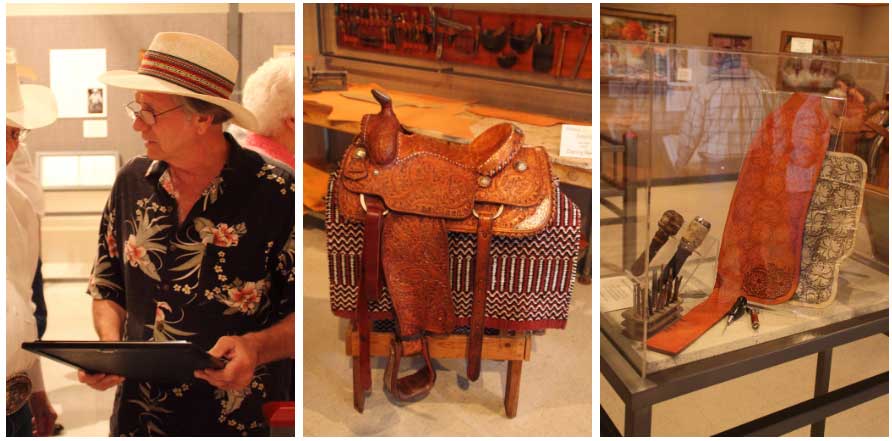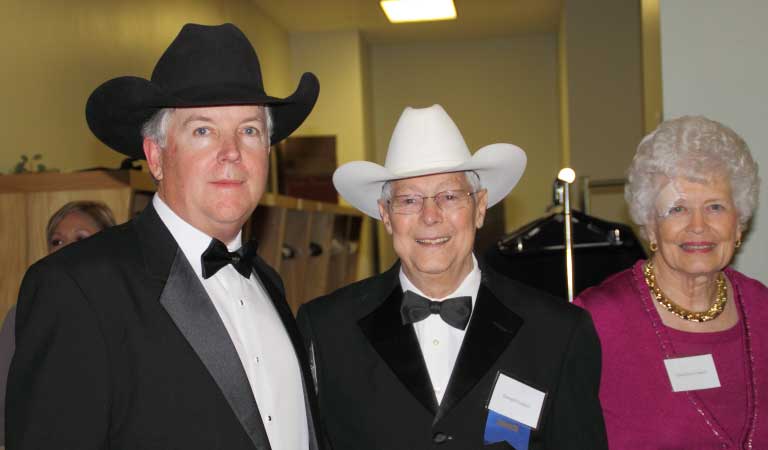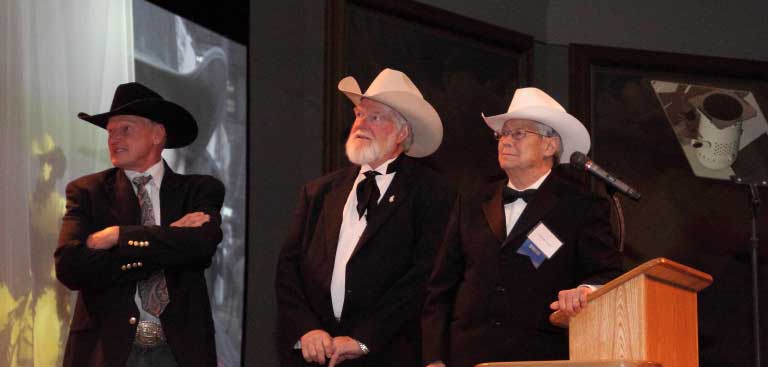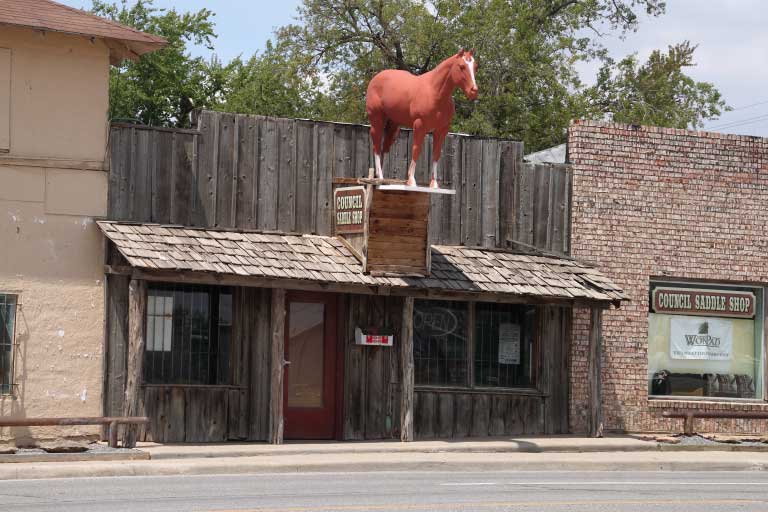
By Nick Pernokas
It was a good day for a fleece lined jacket, or even a quilted down coat, if you had one. The southwestern Oklahoma wind blew cold on that Christmas Eve of 1953. The Christmas party’s host was a roper, so naturally many of his guests were cowboys as well. Famed Oklahoma roper, Dee Burk, was in attendance and he’d brought his brother-in-law, Amye Gamblin, with him. Amye was also a good roper and horse trainer from California. Dee’s talk about the good job that Amye had out west was only reinforced by the new Lincoln parked outside with California plates.
Dee introduced Amye to a young man who liked to rope calves. Amye liked him instantly and invited him out to his car. It was a dark night, but Amye opened his trunk by the light of a flashlight and there, sitting on its side, was a Chuck Sheppard saddle, which had been built by Rowell Saddle Company in California.
“Here’s the best tree I ever rode,” Amye said to Howard Council. “You should try to get some of them.”
“I liked the looks of it,” remembered Howard, almost 50 years later. “It had some swell to it, but it still had just a two-and-a-half-inch cantle. What I liked about the original Chuck Sheppard was that it had some swell, like an Association but lower. I guess that’s what Chuck liked since he was a bronc rider. Later they started calling a lot of saddles ‘Chuck Sheppard’s’ and they weren’t anything like that.”

This Christmas Eve encounter would turn out to be a watershed moment for the calf roping industry, but Howard Council’s story begins a lot earlier.
Howard was born in Durant, Oklahoma, in 1926. When he was five, his family moved to Lawton, Oklahoma, and that would be where he remained for the rest of his life. When Howard was 13 or 14, his family bought a house outside of town. Even though Howard’s family had never been involved with horses, Howard had always wanted one. Then, he bought a horse and built a pen for it.
At the time, southwestern Oklahoma was home to a lot of cowboys who were competing in the sport of calf roping. As a teenager, Howard became interested in calf roping and started learning from some of the local ropers. He fell in love with the sport, but his smaller stature hindered him at a time when the calves roped at rodeos were fairly large.
In 1944, Howard became interested in working with leather. He had wanted a belt with his name on it, which was a big deal at the time. A man came to town and ran an ad in the paper saying that he made belts. The craftsman was just passing through, but he rented a house for a while and set up shop in it. He made Howard a belt and Howard was fascinated with the tooling process. He asked the man where he could get some stamping tools and the man gave him an address of a company in Tulsa. Howard didn’t know what tools to order, but he looked at his new belt and figured out which ones would apply. There weren’t any books available to Howard, so he taught himself how to tool leather through trial and error with his belt as a model.
“I just taught myself to carve leather,” said Howard.
At the time, Howard’s day job was driving a wholesale magazine truck.
“I started making belts and I was roping calves, but I couldn’t beat anybody. It was just a hobby.”
Howard quit roping in 1947, and married Genevieve Thomas in 1949. At night he made belts for many of his roping friends. Genevieve’s uncle suggested that he should open a leather shop. At first Howard was skeptical, but soon his orders were piling up.
“One thing about the roping was that I got to know a lot of ropers and even got to working on some saddles for them.”
The more Howard thought about it, the more he liked the idea of his own shop.
“I was so damn dumb I didn’t know what I was doing. There we were, newly married, me a nobody and I hung my shingle out in the corner of my wife’s uncle’s upholstery shop, and thought I’d automatically start making a living. Boy, it was pretty rough, just making belts, billfolds, whatever anybody wanted.”
One day, a friend that had roped with Howard asked him if he could build a saddle. Howard told him that he’d torn a lot of them apart to repair them, so he thought he could. The cowboy offered to pay for the materials if Howard wanted to experiment. Howard began to build the saddle in his spare time on a Fred Lowery saddle tree. It was a style that many ropers were using then. It had a two-inch cantle, no swell and a Mexican horn.
“That’s what they all rode back then. Well, it worked and it was a full-carved saddle of all things. I should have made it plain since I wasn’t getting paid for it.”
Soon, someone else wanted one built and while Howard wasn’t making a living from it, he was getting a lot of experience.

By the time of the 1953 Christmas party, Howard had the fundamentals of saddle construction mastered. Dee and Amye had handed him a blueprint for the future of roping saddles. In dusty little arenas around Oklahoma, ropers were figuring out new techniques for better trained rope horses and faster runs. They were ready for a saddle built exclusively for the sport. Howard bought two Chuck Sheppard saddle trees from Rowell. One was used to retree a customer’s saddle and the other was made up as a rough out saddle for another customer. The saddle cost $135 and it fit a horse well. Ropers were becoming more aware of how their horses worked with a better fitting saddle and word of Howard’s saddles spread. The ball was rolling and Howard built a lot of saddles on the old CS tree. Howard bought just enough leather for one saddle at a time from a jobber.
“I look back now and I don’t know how we were making a living at it.”
Howard was busy and working all night long when he had to. He tried to make the best saddle he could and still get them turned out. He was able to turn out one saddle a week. Howard started to experiment with other styles of saddle trees. He saw a Toots Mansfield roping saddle that Porter’s Saddlery in Phoenix had made and really liked it. P.Q. Ritter from Portland, Oregon, made the trees for Porters.
“The original was designed by Toots and it wasn’t like the ones you see now. It was leveler on the top and had more swell showing. I try to change mine more like the originals. Toots was my hero so I did a few things like the Porters.”
Howard used an inskirt rigging that was similar to Porter’s on many of his saddles. He felt that they were just as strong as a conventional rigging.
“If you look at these pictures of ropers in my saddles, you can see exactly what I’m trying to do. I want their feet under them, never behind; they don’t have to lean forward to get against the swell. Their feet are locked in under them.”
Howard found out early in his career that one saddle wouldn’t fit every horse. He really liked the original CS Rowell bars, but thought that later tree makers began rounding the bars too much on the bottom. Around 1960, Howard began flattening the bottoms of the bars himself. He wasn’t really doing it for an individual fit, but rather to make them flatter like the old Rowell trees. Howard also began experimenting with fiberglass then. The saddle trees were single covered rawhide and he would recover the bottoms of the bars with fiberglass after he worked on them.
Around 1980, Howard shaped the bars on a tree to fit Barry Burk’s horse, Bandit. Immediately, he was flooded with ropers wanting saddles custom fitted to their horse’s backs.
“After that I was doing a lot of them that way. Many of them I didn’t need to and it was taking a lot of time. They’d come by with their horses to have me look at them and make a mold of their backs. The word got out that that was what needed to be done I guess, and in some cases maybe it did. I used to have all the molds here with the names of the horses and the rider on them. I quit doing it because it was just taking up too much time.”
One year, Roy Cooper was roping at the National Finals Rodeo in Oklahoma City. He was riding a Council saddle that had the bars shaped to fit the particular horse he was riding. When he had to change mounts in the middle of the week, he called Howard and Howard drove up and looked at the other horse. Howard took the saddle home and pulled it apart. He worked all night, changed the shape of the bars to fit the new horse and got the saddle back to Cooper in time for the next night’s performance.
Howard never liked geometric stamps and most of his saddles were carved with the deep oak or floral tooling that he was famous for. He said that he only made one basket-stamped saddle in his career.
Howard’s customer list read like a who’s who of great ropers. In 1970, he made a saddle for Clifton Smith, the first man to get off a calf horse on the right consistently. Roy Cooper had a Council saddle from the beginning of his pro career and went on to revolutionize the roping game. Howard’s list also included four saddles made for George Strait, as well as a long line of World Champion caliber cowboys like Junior Garrison, Stran Smith, Jimmie Cooper, Tom Ferguson, Cody Ohl, Trevor Brazile and Rabe Rabon. Howard even did some work for Garth Brooks.

Unlike most saddlemakers, Howard also kept a list of all the customers who never got a saddle. These were the ones that passed away, cancelled or just disappeared before he got to make their saddles.
Howard became the most copied saddlemaker in the roping discipline, which, while flattering, was also a source of aggravation for him. One time, he got a call from a champion calf roper about one of the saddles that he’d made him. The roper had been at an arena in Oklahoma tuning up his calf horse, when the swell of the saddle had pulled loose from the jerk of the calf. Howard was extremely upset and embarrassed. He picked up the saddle to bring it home and repair it. When he got it back to his shop and looked at it, he noticed that the saddle parts didn’t fit together very well. When he looked at the tree, he found that it wasn’t even the one that he’d built the saddle on. When Howard called the roper, he found that a saddle company was trying to do an endorsement deal with the roper and had taken the tree out to copy it. They had replaced it with their prototype tree, which was the one that had broken.
After several more instances of having his saddles pulled apart by saddle companies in endorsement deals, Howard started telling his customers that he would give them the tree to get copied if they were endorsing a production saddle, rather than pulling a good saddle apart.
Howard’s shop was in an unassuming building in an older part of Lawton. The only indication of the small tack shop in the front of the building, or the smaller saddle shop in the rear, was a fiberglass horse mounted over the door of the false-fronted store. When you went in the front door, you immediately found yourself immersed in the roping world. You were surrounded by photos and memorabilia that went all the way back to a headstall used by Tom Mix. In addition to the roping memorabilia, the tack shop had prints of some of Howard’s paintings on the walls. Howard was modest about his hobby and would tell you that he felt guilty about occasionally painting at night. Judging from the correspondence from artists like Orren Mixer (who painted a scene on a carved fender that Howard hadn’t liked and thrown out), the professionals thought he was pretty good. That fender was mounted on an old barn board and sat next to a three-dimensional leather horse head that was tooled, molded and painted by Howard in a combination of all his mediums. Genevieve ran the tack shop in the front, so Howard could concentrate on building saddles in the small shop in the rear.
“My whole life’s been in this shop. I’ve always worked alone and I’ve never been inside another saddle shop, or got to meet another saddle maker,” Howard told me in 2001. “I’ve really enjoyed my relationship with all our customers. We meet them from all over the United States and a lot of them have become really good friends.” Howard was an institution in the rodeo world and received accolades for it. In April 2011, at the venerable National Cowboy and Western Heritage Museum, 84-year-old Howard received the Chester A. Reynolds Memorial Award. Howard was surrounded by many celebrities that night at the Western Heritage Awards. Ed Harris and Rex Linn were the masters of ceremony. Barry Corbin, Ernest Borgnine, Stewart Whitman and Buck Taylor were all there to rub elbows with. The folks that Howard talked to the most though were his cowboy friends who filled up several tables. They all came to honor him and the saddles that he’d made for them. And, as Howard requested, Roy Cooper presented him with his award.
Later that year, Howard was honored by the Museum of the Great Plains in Lawton, when they unveiled the Council Saddle Shop display. The permanent exhibit was a saddle shop modeled after Howard’s. Many of his tools and paintings were included in the shop. Space was reserved for Howard’s fiberglass horse, which would reside there whenever Howard decided to retire.

Well, Howard never did retire. I have met many great saddlemakers and Howard was by far the most enthusiastic. He built saddles until he couldn’t see them anymore and then he got someone to drive him to the shop every day. There he could visit with his old customers, many of whom would bring their grandkids in to share this piece of history with them.
The last time that I saw my old friend was a couple of weeks before he passed away. He sat on a couch in his living room with a blanket wrapped around him to ward off the Oklahoma chill. We talked of saddles and ropers, and occasionally Genevieve would find a picture or a catalogue for him to make a point with. When I left, he was planning on making a trip down to the shop to check on something.
Howard was always a gentleman in every sense of the word. He was proud inside of the work that he’d done, but he was humble in the way he talked about it. He always had time and a kind word for others.
Howard Council passed away on November 10, 2014, at the age of 87.
This article originally appeared on Shoptalk Magazine and is published here with permission.
You can find all kinds of interesting articles in our section on Tack & Farm.
































